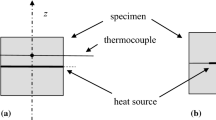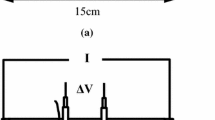Abstract
A transient plane source measurement technique is applied to assessing the heat capacity and thermal conductivity of hydrating cement pastes in their fresh state and during the course of 28 d of hydration at 20°C. Variables investigated include water-to-cement mass ratio (w/c – 0.3 or 0.4) and curing conditions (sealed or saturated curing). The heat capacity data for the fresh cement pastes are compared to a simple law of mixtures, and analytical expressions are developed to estimate the heat capacity as a function of degree of hydration for the two curing conditions. The measured thermal conductivities of the fresh pastes along with the known thermal conductivity of water are used to estimate the thermal conductivity of the original cement powder via application of the Hashin-Shtrikman (H-S) bounds. Hydration is seen to have only a minor influence on the measured thermal conductivity. Extension of the law of mixtures for heat capacity and the H-S bounds for thermal conductivity to predicting the corresponding properties of concretes are discussed.
Résumé
Une technique basée sur une source de chaleur pulsée est utilisée pour déterminer la capacité calorifique et la conductivité thermique de pâtes de ciment à l’état frais et pendant les 28 premiers jours d’hydratation à 20°C. Les variables étudiées sont le rapport eau-ciment en masse (e/c 0.3 ou 0.4) et les conditions de cure (éprouvettes scellées ou dans l’eau). Les mesures de capacité calorifique des pâtes de ciment fraîches sont comparées avec la simple loi des mélanges. Des expressions analytiques ont été développées pour estimer la capacité calorifique en fonction du degré d’hydratation pour les deux conditions de cure. La conductivité thermique de la poudre de ciment utilisée est estimée à l’aide des valeurs de conductivité thermique mesurées et de la conductivité thermique de l’eau par la méthode des limites Hashin-Shtrikman. Le degré d’hydratation semble avoir une influence mineure sur la valeur de la conductivité thermique mesurée. L’utilisation de l’extension de la loi des mélanges pour la capacité calorifique et des limites H-S pour la conductivité thermique afin de prédire les propriétés correspondantes du béton est discutée.
Similar content being viewed by others
References
Kapila D, Falkowsky J, Plawsky JL (1997) Thermal effects during the curing of concrete pavements. ACI Mater J 94(2):119–128
Bentz DP (2000) A computer model to predict the surface temperature and time-of-wetness of concrete pavements and bridge decks. NISTIR 6551
Waller V, De Larrard F, Roussel P (1996) Modelling the temperature rise in massive HPC Structures. In 4th International Symposium on Utilization of High-Strength/High-Performance Concrete RILEM, Paris, 415–421
McCullough BF, Rasmussen RO (1999) Fast-Track Paving: Concrete Temperature Control and Traffic Opening Criteria for Bonded Concrete Overlays. FHWA-RD 98–167
De Schutter G, Taerwe L (1995) Specific heat and thermal diffusivity of hardening concrete. Mag Concrete Res 47(172):203–208
Bouguerra A, Laurent JP, Goual MS, Queneudec M (1997) The measurement of the thermal conductivity of solid aggregates using the transient plane source technique. J Phys D: Appl Phys 30:2900–2904
Kim KH, Jeon SE, Kim JK, Yang S (2003) An experimental study on thermal conductivity of concrete. Cement Concrete Res 33:363–371
Xu Y, Chung DDL (2000) Effect of sand addition on the specific heat and thermal conductivity of cement. Cement Concrete Res 30:59–61
Demirboga R, Gul R (2003) The effects of expanded perlite aggregate, silica fume, and fly ash on the thermal conductivity of lightweight concrete. Cement Concrete Res 33:723–727
Gibbon GJ, Ballim Y (1998) Determination of the thermal conductivity of concrete during the early stages of hydration. Mag Concrete Res 50(3):229–235
Khan AA, Cook WD, Mitchell D (1998) Thermal properties and transient thermal analysis of structural members during hydration. ACI Mater J 95 (3):293–303
Mounanga P, Khelidj A, Bastian G (2004) Experimental study and modelling approaches for the thermal conductivity evolution of hydrating cement paste. Adv Cement Res 16 (3):95–103
Morabito P (2001) Thermal properties of concrete: variations with the temperature and during the hydration phase. BE96–3843/2001:18–4
Demirboga R (2003) Influence of mineral admixtures on thermal conductivity and compressive strength of mortar. Energy and Buildings 35(2):189–192
Hansen PF, Hansen J, Hougaard K, Pedersen EJ (1982) Thermal Properties of Hardening Cement Paste. In: Proceedings of RILEM international conference on concrete at early ages, RILEM, Paris, 1982, 23–36
Cement and Concrete Reference Laboratory (2004) Cement and Concrete Reference Laboratory Proficiency Sample Program: Final Report on Portland Cement Proficiency Samples Number 151 and 152, 2004
Gustafsson SE (1991) Transient plane source techniques for thermal conductivity and thermal diffusivity measurements of solid materials. Rev Sci Instrum 62(3):797–804
Log T, Gustafsson SE (1995) Transient Plane Source (TPS) technique for measuring thermal transport properties of building materials. Fire Mater 19:43–49
He Y (2005) Rapid Thermal conductivity measurement with a hot disk sensor part 1. Theoretical considerations. Thermochimica Acta 436:122–129
Bentz DP (1997) Three-dimensional computer simulation of cement hydration and microstructure development. J Am Ceram Soc 80(1):3–21
Molina L (1992) On predicting the influence of curing conditions on the degree of hydration. CBI Report 5:92
Holman JP (1981) Heat transfer. McGraw-Hill, New York
Todd SS (1951) Low-Temperature heat capacities and entropies at 298.16 K of crystalline calcium orthosilicate, zinc orthosilicate, and tricalcium silicate. J Am Chem Soc 73:3277–3278
CRC Handbook of Chemistry and Physics (1987) CRC Press, Boca Raton, FL
Thomas JJ, Jennings HM, Allen AJ (1998) The surface area of cement paste as measured by neutron scattering - evidence for two C-S-H morphologies. Cement Concrete Res 28(6):897–905
Snyder KA, Bentz DP (2004) Suspended hydration and loss of freezable water in cement pastes exposed to 90% relative humidity. Cement Concr Res 34:2045–2056
Bentz DP (1999) Modelling cement microstructure: pixels, particles, and property prediction. Mater Struct 32:187–195
Bentz DP, Stutzman PE (2006) Curing, hydration, and microstructure of cement pastes. ACI Mater J 103(5):348–356
Hashin Z, Shtrikman S (1962) A variational approach to the theory of the effective magnetic permeability of multiphase materials. J Appl Phys 33:3125–3131
Horai K (1971) Thermal conductivity of rock-forming minerals. J Geophys Res 76(5):1278–1308
Vosteen HD, Schellschmidt R (2003) Influence of temperature on thermal conductivity, thermal capacity, and thermal diffusivity for different types of rocks. Phys Chem Earth 28:499–509
Acknowledgements
The author would like to thank Dr. Jim Beaudoin of National Research Council Canada for pointing out the C3S/C2S heat capacity reference [23], Mr. Mattias Gustavsson of Hot Disk AB (Sweden) for his advice on the thermal measurement procedures employed in this study, Dr. Joel Plawsky of Rensselaer Polytechnic Institute for a thorough review of the manuscript, and Dr. Chiara Ferraris of BFRL/NIST for providing the French translation of the abstract.
Author information
Authors and Affiliations
Corresponding author
Rights and permissions
About this article
Cite this article
Bentz, D.P. Transient plane source measurements of the thermal properties of hydrating cement pastes. Mater Struct 40, 1073–1080 (2007). https://doi.org/10.1617/s11527-006-9206-9
Received:
Accepted:
Published:
Issue Date:
DOI: https://doi.org/10.1617/s11527-006-9206-9




